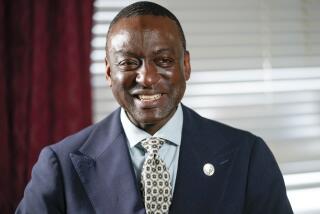A Man on the Run Since 1935
- Share via
NEW YORK — Some people retire to gated communities, others to golf courses or condos by the sea.
Not 86-year-old Alberto Arroyo. Rain or shine, he can be found here, at the running track and reservoir in Central Park.
“This reservoir is my home, my church, my studio, whatever you want to call it,” Arroyo said, declining an umbrella on a day when wisps of fog drifted over the Jacqueline Kennedy Onassis Reservoir. “When there are beautiful days . . . everyone flocks here. This to me is a beautiful day.”
In large measure, Arroyo embodies the spirit of the park, designed in 1858 by Frederick Law Olmsted and Calvert Vaux as a refuge from the chaos, congestion and concrete of Manhattan.
He is the park’s unofficial mayor, a man whose passion for the place has been celebrated by a proclamation from the New York Legislature.
When the Museum of the City of New York collected 100 items symbolizing the fabric of the city as part of its millennium exhibition, a statue of Arroyo was No. 84.
He is, in fact, considered one of the fathers of the fitness movement in America.
“Since 9 years old, I was an athlete,” Arroyo, who was born in Aguadilla, Puerto Rico, recalled recently. “I used to play baseball, but my specialty was boxing.”
He arrived in New York in 1935, found work and met other boxers--who advised him to run in Central Park as part of his training.
200,000 Miles and Counting
In those days, it was not easy being a fitness pioneer.
At the Bethlehem Steel Corp., where he worked in a series of jobs for 30 years, Arroyo spent his lunch hours running from Battery Park to 34th Street and back. One day, he said, his boss called him into the office.
“ ‘I hear you are running in the park and shadowboxing. You are an embarrassment,’ he said. He wanted me to be in the office smoking, drinking coffee and playing cards like everybody else.
“I told him, between 12:30 and 1:30 you cannot tell me what to do. If I want to stand on my head, that is my business. . . . Today, it would be different. Instead of calling me an embarrassment, they would give me a plaque, a badge.”
Since he started jogging 66 years ago, Arroyo estimates he’s run more than 200,000 miles.
And as maestro of the 1.6-mile Central Park track, he serves as a confidant, confessor and occasional matchmaker.
Some days, the crush of joggers rivals rush hour in Times Square, and celebrity sightings are common.
Arroyo said that when he first saw Jacqueline Kennedy jogging around the reservoir after she left the White House, she was accompanied by a bodyguard. Later, she ran alone.
“For five years I didn’t speak to her,” he said. One day, Arroyo worked up the nerve to say good morning to the former first lady. “I know who you are, and I respect your privacy,” he told her. “She said: ‘I have seen you here too, and when I see you at a distance, I feel safer.’ ”
Arroyo asked if he could run with her, and she agreed. After a couple of such outings, Arroyo said, he was still unsure how to address her. “ ‘You call me Jackie,’ she said. After that, I used to kid with her. ‘Hey Jackie, you look great. You’re athletic!’ ‘Look who’s talking,’ ” Arroyo said she would reply. “ ‘You’re my inspiration.’ ”
He said Anthony Quinn once asked him for a remedy for his thickening waistline. “I said eat less and exercise more.”
For years, Arroyo said, he didn’t recognize Madonna.
“I saw this skinny girl come running. One day, she passed by and a bunch of kids yelled, ‘Madonna!’ I asked: ‘Who’s Madonna?’ . . . She came here to do her own thing. She did not want to be covered with people. I left her alone. Kim Basinger was more friendly.”
In a city that often puts a premium on high-pressured achievement, Arroyo’s presence in the park and the hundreds of friendships he has made testify to the benefits of the simple life. He lives alone in a room on the west side of Manhattan, supported by Social Security and a small pension from the steel company.
His basic philosophy, he says, is to remember the pleasant things and forget the unpleasant things. Arroyo also has never forgotten this advice from his father: Don’t smoke or drink or gamble or carry guns or argue with people.
On a recent evening, he sat on a bench in front of the reservoir’s pump house. The proclamation by the state Legislature was displayed in a window of the gray stone structure. It called Arroyo a “remarkable inspiration” and “the dean of the Central Park reservoir runners.” Alongside it was a letter of praise from former Wisconsin Sen. William Proxmire.
An Integral Part of the Park’s Allure
Several joggers paused by the bench to chat.
“To have the determination and pure, simple passion at the age of 86 to rise every morning and go to the place he loves, the place he calls home, his beloved Central Park, that is something to celebrate,” said Nancy Linday, an urban planner who finished eighth among female runners in the 1975 New York Marathon.
“I have known him for so long now, it’s amazing,” she said later while walking on the track. “I am thinking, what would the reservoir be like without Alberto? Why would I want to go there? I can look at trees anywhere. . . . You realize just how much a part of the draw this person is.”
More to Read
Sign up for Essential California
The most important California stories and recommendations in your inbox every morning.
You may occasionally receive promotional content from the Los Angeles Times.













